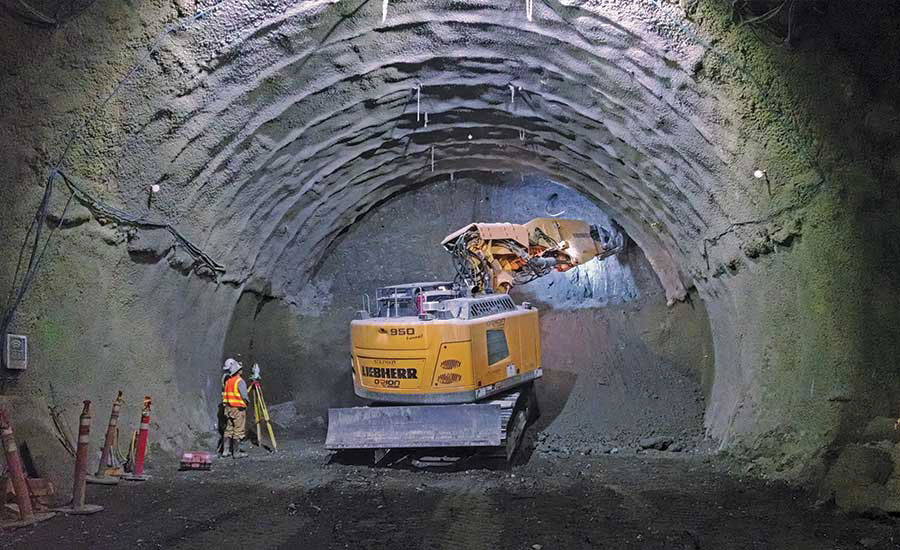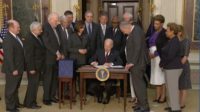President Joe Biden’s $1.9-trillion coronavirus relief proposal has gone on the books with a short bill signing on March 11, one day after the measure won final congressional approval. The measure has relatively little direct funding for construction or infrastructure projects, but it does provide a major injection of funds to help ailing multiemployer pension plans. Multiemployer plans are common in unionized construction.
In brief remarks in the Oval Office before signing the measure, Biden said that "this historic legislation is about rebuilding the backbone of this nation and giving people in this nation—working people, middle-class folks, people who built the country—a fighting chance. That's what the essence of it is."
The legislation, titled the American Rescue Plan Act, cleared Congress On March 10 when the House passed it by a 220-211 vote, nearly along party lines.
The Senate approved the legislation on March 6 by a 50-49 vote, The Senate bill made some changes from the original version passed by the House on Feb. 27. The differences meant that the bill had to have a second House floor vote.
The legislation’s largest specific construction funding provision is a $1.7-billion allocation for transit projects under the Federal Transit Administration’s capital investment grants program.
Of the $1.7 billion, $1.4 billion is allotted to new fixed-guideway and “core capacity-improvement projects.” Eligible projects are those that received agency funding allocations in fiscal 2019 or 2020. The other $250 million will go to projects in FTA’s “small starts” program.
Apart from the $1.7 billion, the package has about $29 billion more for transit agencies. But most of that $29 billion will go for payroll and other operating expenses. That amount supplements the $14 billion that transit agencies received in the coronavirus relief and appropriations bill enacted on Dec. 27.
Under the bill, airport agencies receive $8 billion for purposes such as operating expenses, debt service and aid to airport concessionaires. Amtrak will get $1.7 billion to keep the railroad in full operation through Sept. 30.
Elsewhere in the bill, “repairs and improvements” for K-12 school facilities are among a number of eligible uses for $128.6 billion in aid.
Another use is “inspection, testing, maintenance, repair, replacement and upgrade projects” to improve indoor air quality in schools. That includes heating, ventilation and air conditioning systems, filtering, fans and window and door replacements, the new statute states.
But schools also can use funds for nonconstruction purposes, such as reducing class size, presumably by adding teachers and other personnel, buying personal protective equipment and hiring support staff, according to the House Education and Labor Committee.
In another part of the bill, the Paycheck Protection Program for forgivable loans will receive an additional $7.25 billion.
States, territories and tribal governments will receive $219.8 billion; cities, counties and other localities get $120.2 billion.
The bill has an intriguing Senate-added provision, creating a $10-billion “Coronavirus Capital Projects Fund.” Those monies will flow to the states, for “critical capital projects directly enabling work, education and health monitoring, including remote options” that respond to the COVID-19 pandemic, the bill's text says. It doesn’t rule construction uses in or out.
Brian Turmail, an Associated General Contractors of America spokesman, cautions that the universe of potentially eligible projects for the fund is “very large and does not ensure that this money will go to capital construction investments in infrastructure.”
Susan Howard, program director for transportation finance at the American Association of State Highway and Transportation Officials, said in emailed responses to ENR questions, “I think it’s difficult to say definitively what kind of capital investment would be eligible.” Howard adds that the measure doesn’t mention the Dept. of Transportation or the U.S. Code section that applies to surface transportation. That, she says, “leaves me skeptical about its applicability to federal-aid transportation projects.”
The measure also includes sweeping changes to the struggling multiemployer pension program, which affects companies, workers and retirees in construction’s unionized sector.
The key element calls for an infusion from the government’s general fund to the Pension Benefit Guaranty Corp., which administers the federal pension-plan assistance program, to provide financial help to multiemployer plans judged to be in “critical and declining” condition in 2020, 2021 or 2022.
The AFL-CIO welcomed the multiemployer pension assistance, but key Senate Republicans blasted it as a bailout.
Story updated on 3/11/2021 with bill signing.




Post a comment to this article
Report Abusive Comment